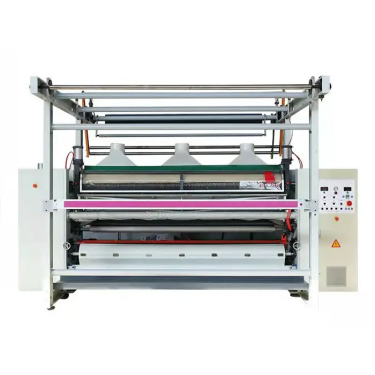Fabric sanding Brushing Brushing Sanding refers to rubbing on the cloth surface with a sanding roller or a metal roller; different fabrics are combined with different sanding meshes to achieve the desired sanding effect. The general principle is to use high-mesh sand skins for high-count yarns, and low-mesh sand skins for low-count yarns. The sanding rollers are used for forward rotation and reverse rotation, and an odd number of sanding rollers is generally used. The factors that affect the sanding effect of sanding are: the speed of the sanding roller, the speed of the machine, the moisture content of the cloth body, the covering angle, the tension, etc.; Forming hairiness; it has the same meaning as pulling hair, just a different way of saying it; different fabrics use different steel needles, which can be divided into round and pointed. Generally speaking, cotton uses pointed and wool uses round; Influencing factors are: speed, rotating speed of card clothing roller, number of card clothing rollers, moisture content, tension, card clothing density, steel needle bending angle, yarn twist, pre-treatment additives, etc.; The bristle roller sweeps across the cloth surface; different fabrics and treatments use different bristle rollers, there are pig bristle brushes, steel wire brushes, carbon wire brushes, and ceramic fiber brushes. For simple treatment, use bristle brushes, such as brush cloth before singeing; steel wire brushes are generally used for fabrics that require severe napping, such as knitted flannelette; carbon wire brushes are used for high-grade cotton fabrics, and the surface treatment requirements are fine; the treatment requirements are more Fine use ceramic fibers. Influencing factors: number of brush rollers, rotating speed, stiffness of brush filaments, fineness of brush filaments, density of brush filaments, etc. Supplement: Gripping and napping are the same concept, that is, the same process. The equipment used is a napping machine, which uses a steel needle roller to pull out the microfibers in the fabric yarn to form a fluffy effect on the surface. The specific products include flannelette, Silver wool and the like, the napping process is also called “fleece”; the equipment used in the sanding process is a sanding machine, which uses sand, carbon, ceramic and other rollers to grind out the microfibers in the fabric yarn to form a surface. Compared with brushed products, the brushed fluff is short and dense, and the wool feels very delicate. Specific products include brushed yarn cards, brushed poplin, peach skin, etc., and some brushed products look like wool. It is not obvious, but the hand feel has been greatly improved; the bristles are mainly a special process for corduroy, because the fluff of the corduroy cuts the weft yarn of the surface tissue, and the yarn is broken up by the bristles to form a cohesive pile. The equipment used is The brushing machine is generally equipped with 8-10 hard brushes and 6-8 crawler soft brushes. The thick corduroy needs to pass through the back brush. In addition to the hard and soft brushes, the back brush machine is also equipped with a wax plate. During the brushing process At the same time, waxing the fluff makes the corduroy strips shiny, so the back brushing machine is also called a waxing machine.

REHOW provides textile industrial machines to the whole world, helping them improve efficiency and reduce labor cost. ReHow provides various types of textile machinery: raising machine, cloth inspection machine, packing machine, coiling machine, slitting machine, cross cutting machine, ribbon weaving machine, weaving machine, etc. If you are interested in us, please contact us now!
Post time: Apr-24-2023





